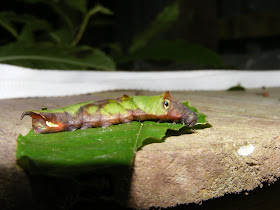It has been a while since I have had a solid post dedicated to caterpillar eyespots. I have now returned from by research trip to Costa Rica, but I will try to keep sharing its beautiful diversity through the photos and videos that I captured while I was there. The last caterpillar I observed on my final official day of caterpillar data collection was quite an exciting specimen. I was particularly excited because this caterpillar exhibited some interesting body posture changes upon my simulated attacks (i.e., light pinching with forceps).
The photo above shows the typical resting position of this caterpillar (at least in this instar). Very cryptic, with dashes of brown that cross the body and break up its outline - a strategy known as "disruptive colouration". Note also that the caterpillar folds its body in such a way that the brown on the anterior end seems to line up with the brown on the central part of the body. This seems to be a good example of a special form of disruptive colouration termed "coincident disruptive colouration" where crypsis is increased through preventing detection of revealing body parts by visually joining them with other parts of the animal's body.
Interestingly, similar colour patterns in caterpillars caught the attention of Edward Bagnall Poulton who was one of the early evolutionary biologists / naturalists to take a close look at animal coulouration and ponder its function. His book "The colours of animals: their meaning and use, especially considered in the case of insects" published in 1890 remains a highly regarded (and cited) work on animal colour patterns and their function. For a great synthesis on disruptive coloutarion and its various functions see Martin Stevens and Sami Merilaita's recent paper on the subject:
Stevens, M. and Merilaita, S. (2009) Defining disruptive coloration and distinguishing its functions.Philos Trans R Soc Lond B Biol Sci. 364: 481-488
Once the caterpillar realizes that it has been discovered it reveals its previously hidden eyespots:
When attacked, the caterpillar pulls in its head and puffs out the body segments that have eyespots:
This is very similar to the behavour I observed in Papilio canadensis caterpillars upon attack and the behaviour apparently observed in many caterpillars with eyespots, including Sphingidae caterpillars from the genus Xylophanes (e.g. X. tersa).
Therinia transversaria (Saturniidae)
The photo above shows the typical resting position of this caterpillar (at least in this instar). Very cryptic, with dashes of brown that cross the body and break up its outline - a strategy known as "disruptive colouration". Note also that the caterpillar folds its body in such a way that the brown on the anterior end seems to line up with the brown on the central part of the body. This seems to be a good example of a special form of disruptive colouration termed "coincident disruptive colouration" where crypsis is increased through preventing detection of revealing body parts by visually joining them with other parts of the animal's body.
Interestingly, similar colour patterns in caterpillars caught the attention of Edward Bagnall Poulton who was one of the early evolutionary biologists / naturalists to take a close look at animal coulouration and ponder its function. His book "The colours of animals: their meaning and use, especially considered in the case of insects" published in 1890 remains a highly regarded (and cited) work on animal colour patterns and their function. For a great synthesis on disruptive coloutarion and its various functions see Martin Stevens and Sami Merilaita's recent paper on the subject:
Stevens, M. and Merilaita, S. (2009) Defining disruptive coloration and distinguishing its functions.Philos Trans R Soc Lond B Biol Sci. 364: 481-488
Once the caterpillar realizes that it has been discovered it reveals its previously hidden eyespots:
When attacked, the caterpillar pulls in its head and puffs out the body segments that have eyespots:
This is very similar to the behavour I observed in Papilio canadensis caterpillars upon attack and the behaviour apparently observed in many caterpillars with eyespots, including Sphingidae caterpillars from the genus Xylophanes (e.g. X. tersa).















